[1]
United Nations, World Urbanization Prospects, (2014).
Google Scholar
[2]
Information on http://ec.europa.eu/clima/policies/strategies/2030/index_en.htm.
Google Scholar
[3]
H. Lund, S. Werner, R. Wiltshire, S. Svendsen, J. Eric Thorsen, F. Hvelplund, B.V. Mathiesen, 4th Generation District Heating (4GHD): Integrating smart thermal grids into future sustainable energy systems, Energy 68 (2014) 1-11.
DOI: 10.1016/j.energy.2014.02.089
Google Scholar
[4]
L. Pérez-Lombard, J. Ortiz, C. Pout, A review on buildings energy consumption information, Energy Build. 40 (3) (2008) 394-398.
DOI: 10.1016/j.enbuild.2007.03.007
Google Scholar
[5]
J. Keirstead, M. Jennings, A. Sivakumar, A review of urban energy system models: Approaches, challenges and opportunities, Renewable and Sustainable Energy Reviews 16 (6) (2012) 3847-3866.
DOI: 10.1016/j.rser.2012.02.047
Google Scholar
[6]
C.F. Reinhart, C.C. Davila, Urban building energy modeling – A review of a nascent field, Build. Environ. 97 (2016) 196-202.
DOI: 10.1016/j.buildenv.2015.12.001
Google Scholar
[7]
G. Zucker, F. Judex, M. Blöchle, M. Köstl, E. Widl, S. Hauer, A. Bres, J. Zeilinger, A new method for optimizing operation of large neighborhoods of buildings using thermal simulation, Energy Build. 125 (2016) 153-160.
DOI: 10.1016/j.enbuild.2016.04.081
Google Scholar
[8]
M. Fuchs, J. Teichmann, M. Lauster, P. Remmen, R. Streblow, D. Müller, Workflow automation for combined modeling of buildings and district energy systems, Energy 117 (2) (2016) 478-484.
DOI: 10.1016/j.energy.2016.04.023
Google Scholar
[9]
U. Eicker, J. Schumacher, M. Zirak, N. Bartke, R. Nouvel, V. Coors, An Automated Method for Urban Energy Simulation Based on 3D City Models, in: Proceedings of 14th Conference of International Building Performance Simulation Association, India, 2015, pp.2477-2482.
DOI: 10.26868/25222708.2015.2938
Google Scholar
[10]
T. Dogan, C. Reinhart, P. Michalatos, Autozoner: an algorithm for automatic thermal zoning of buildings with unknown interior space definitions, Journal of Building Performance Simulation 9 (2) (2016) 176-189.
DOI: 10.1080/19401493.2015.1006527
Google Scholar
[11]
Information on https://www.postgresql.org.
Google Scholar
[12]
Information on http://www.equa.se/en.
Google Scholar
[13]
P. Nageler, G. Zahrer, R. Heimrath, T. Mach, F. Mauthner, I. Leusbrock, H. Schranzhofer, C. Hochenauer, Novel validated method for GIS based automated dynamic urban building energy simulations, Energy (2017).
DOI: 10.1016/j.energy.2017.07.151
Google Scholar
[14]
Information on http://www.qgis.org/en/site.
Google Scholar
[15]
Information on https://java.com/en.
Google Scholar
[16]
Information on http://www.gis.steiermark.at/cms/beitrag/11696643/803916.
Google Scholar
[17]
T. Loga, B. Stein. N. Diefenbach, TABULA building typologies in 20 European countries-Making energy-related features of residential building stocks comparable, Energy Build 132 (2016) 4-12.
DOI: 10.1016/j.enbuild.2016.06.094
Google Scholar
[18]
Rainer E, et al. RAHMENPLAN ENERGIE Energy City Graz-Reininghaus: Endbericht RPE_ECR. Austrian Ministry for Transport, Innovation and Technology; (2015).
Google Scholar
[19]
Swiss Society of Engineers and Architects, SIA 2024, Standard-Nutzungsbedingungen für die Energie- und Gebäudetechnik (2006).
Google Scholar
[20]
H. Recknagel, E. Sprenger, K.-J. Albers, Taschenbuch für Heizung + Klimatechnik 2015/16 – Premium-Version, Deutscher Industrieverlag, (2015).
Google Scholar
[21]
U. Jordan, K. Vajen, DHWcalc: Program to Generate Domestic Hot Water Profiles with Statistical Means for User Defined Conditions, in: Proceedings of the ISES Solar World Congress (2005).
Google Scholar
[22]
P. Nageler, G. Schweiger, M. Pichler, D. Brandl, T. Mach, R. Heimrath, H. Schranzhofer, C. Hochenauer, Validation of dynamic building energy simulation tools based on a real Test-Box with thermally activated building systems (TABS): submitted to Energy Build. (2016).
DOI: 10.1016/j.enbuild.2018.03.025
Google Scholar


